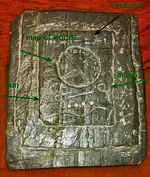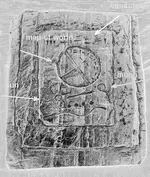DM well gee,overwhelming is what this tablet is,just from reading some on
the use of cuneiform symbols and languages,of the cultures that used it is
a daunting task to fig out,im going to try and find an expert,to send the
img to and see what he/she says,below is some of the reading ive done,its
not a simple thing,it depends what language the cuneiform symbols represent
i sited just 2,the last link explains pretty well how the symbols are used,same
goes for the first link to,as they say,its all in how you say it,LOL
--------------------------
Akkadian cuneiform
http://lila.sns.it/mnamon/index.php?page=Scrittura&id=39&lang=en
list of Akkadian cuneiform symbols
http://www.alain.be/akkadien.html
Cuneiform script[1] is one of the earliest known forms of written expression. Emerging in Sumer around the 30th century BC, with predecessors reaching into the late 4th millennium (the Uruk IV period), cuneiform writing began as a system of pictographs. In the three millennia the script spanned, the pictorial representations became simplified and more abstract as the number of characters in use also grew gradually smaller, from about 1,000 unique characters in the Early Bronze Age to about 400 unique characters in Late Bronze Age (Hittite cuneiform
Transliteration
Cuneiform has a specific format for transliteration. Because of the script's polyvalence, transliteration requires certain choices of the transliterating scholar, who must decide in the case of each signal which of its several poseable meanings is intended in the original thing. For example, the sign DINGIR in a Hittite text may represent either the Hittite syllable an or may be part of an Akkadian phrase, representing the syllable il, it may be a Sumerogram, representing the original Sumerian meaning, 'god' or the determinative for a deity. In transliteration, a different rendition of the same glyph is chosen depending on its role in the present context.
There are differing conventions for transliterating Sumerian, Akkadian (Babylonian) and Hittite (and Luwian) cuneiform texts. One convention that sees wide use across the different fields is the use of acute and grave accents as an abbreviation for homophone disambiguation. Thus, u is equivalent to u1, the first glyph expressing phonetic u. An acute accent, ú, is equivalent to the second, u2, and a grave accent ù to the third, u3 glyph in the series (while the sequence of numbering is conventional but essentially arbitrary and subject to the history of decipherment). In Sumerian transliteration, a multiplication sign 'x' is used to indicate ligatures. As shown above, signs as such are represented in capital letters, while the specific reading selected in the transliteration is represented in small letters. Thus, capital letters can be used to indicate a so-called Diri compound - a sign sequence that has, in combination, a reading different from the sum of the individual constituent signs (for example, the compound IGI.A - "water" + "eye" - has the reading imhur, meaning "foam"). In a Diri compound, the individual signs are separated with dots in transliteration. Capital letters may also be used to indicate a Sumerogram (for example, KUG.BABBAR - Sumerian for "silver" - being used with the intended Akkadian reading kaspum, "silver"), an Akkadogram, or simply a sign sequence of whose reading the editor is uncertain. Naturally, the "real" reading, if it is clear, will be presented in small letters in the transliteration: IGI.A will be rendered as imhur4.
http://en.wikipedia.org/wiki/Cuneiform_script
Sumerian language
http://history-world.org/sumerian[1].pdf




